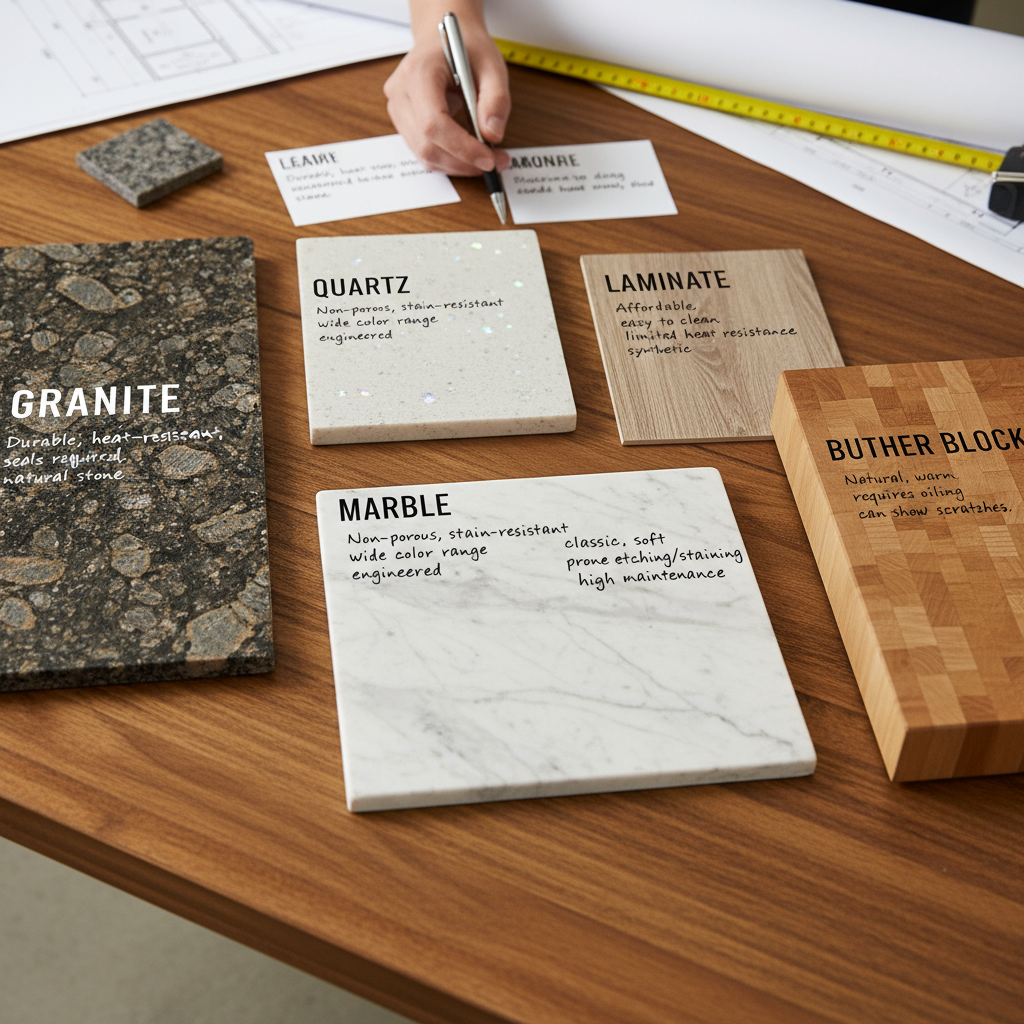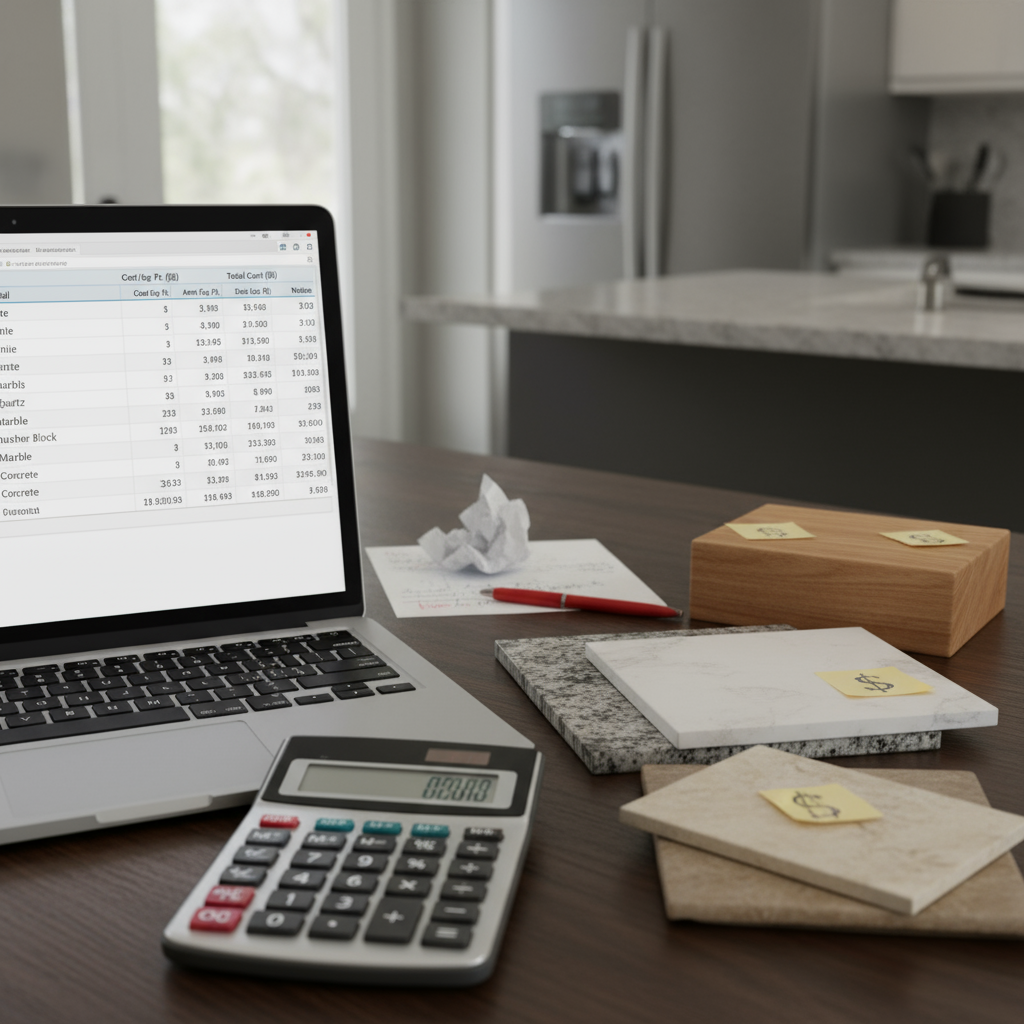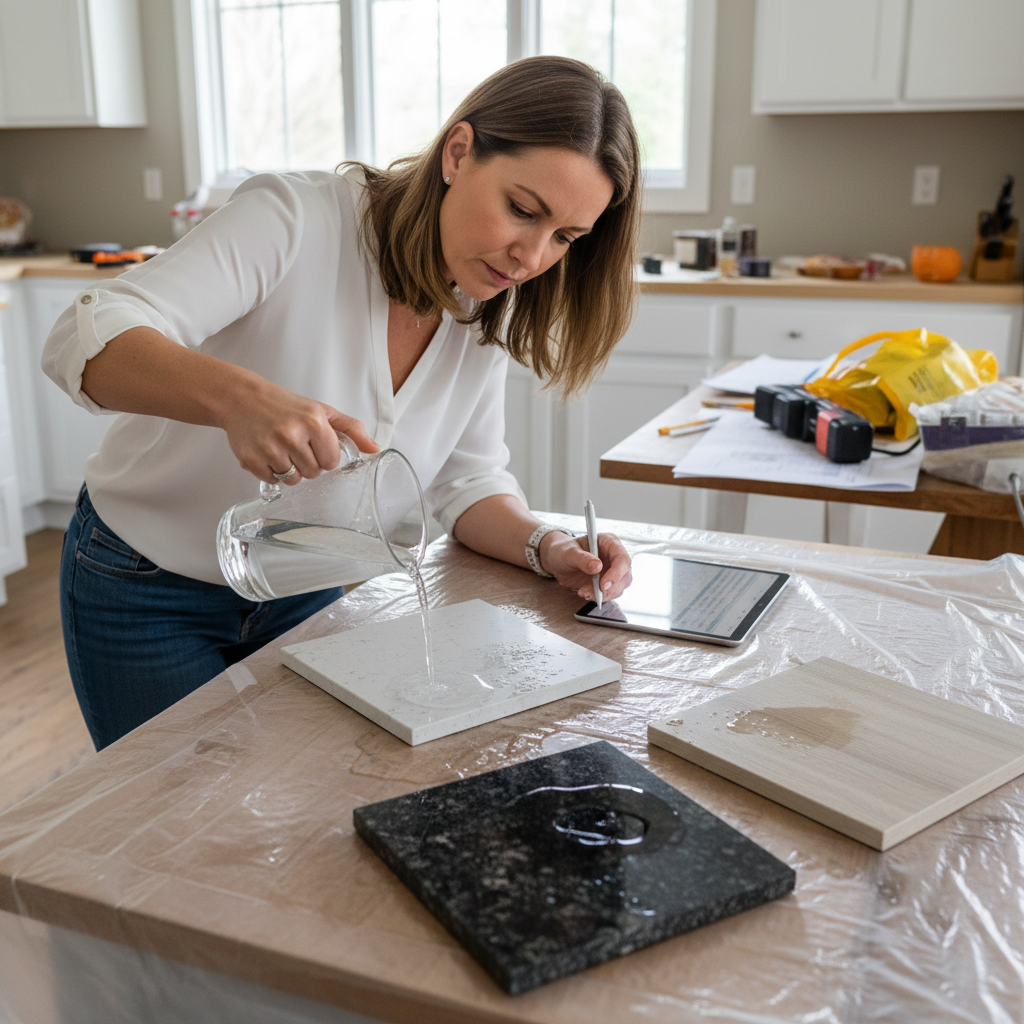TL;DR
- Research material durability for your lifestyle
- Factor in maintenance and cleaning needs
- Compare total costs beyond initial price
- Consult professionals for compatibility
Choosing the right countertop material seems simple, but many homeowners make mistakes that lead to regret, extra costs, or premature replacement. As a kitchen design expert, I’ve seen the consequences of rushed decisions and overlooked factors. Understanding common pitfalls helps you select materials that match your lifestyle and budget.
Common errors range from ignoring durability requirements to inadequate research, resulting in materials that don’t hold up or require excessive maintenance. By avoiding these mistakes, you ensure your countertop choice provides lasting value and satisfaction. Let’s examine the most frequent issues and how to prevent them.

Ignoring Material Durability and Suitability
One of the biggest mistakes is choosing without considering long-term wear.
Underestimating Usage Patterns
Not accounting for daily kitchen activity levels.
- Heavy Cooking: Granite or quartz for frequent meal prep
- Family Kitchens: Stain-resistant materials for kids and pets
- Light Use: Laminate may suffice for occasional cooking
- Commercial-Style: Engineered stone for high-traffic areas
Ignoring Environmental Factors
Failing to consider kitchen conditions.
- Humidity Levels: Moisture-resistant materials for coastal areas
- Temperature Changes: Heat-safe surfaces near ovens/stoves
- Sunlight Exposure: Fade-resistant options for sunny kitchens
- Chemical Exposure: Acid-resistant materials for cleaning products
Overlooking Maintenance Requirements
Choosing materials without understanding care needs.
Cleaning Complexity
Not researching daily maintenance demands.
- Sealing Frequency: Natural stone requires periodic sealing
- Special Cleaners: Some materials need specific products
- Scratch Prevention: Softer materials need cutting boards
- Stain Treatment: Immediate cleanup requirements
Time Investment
Underestimating ongoing care commitments.
- Daily Wiping: High-traffic areas need regular cleaning
- Deep Cleaning: Some materials require professional care
- Repair Possibilities: Ease of fixing chips or scratches
- Lifespan Expectations: How long before replacement needed
Failing to Consider Budget and Value
Focusing only on upfront costs misses total ownership expenses.

Hidden Costs
Not accounting for installation and accessories.
- Fabrication Fees: Cutting and edging costs vary by material
- Installation Labor: Complex materials cost more to install
- Edge Treatments: Decorative edges add significant cost
- Waste Factor: Some materials have higher waste percentages
Long-Term Value
Ignoring future costs and resale impact.
- Maintenance Expenses: Annual cleaning and repair costs
- Replacement Timeline: How often material needs updating
- Resale Value: Premium materials may increase home value
- Insurance Considerations: Some materials affect homeowner insurance
Not Accounting for Aesthetic Compatibility
Choosing materials that clash with kitchen design.

Color Coordination
Not considering overall kitchen color scheme.
- Cabinet Harmony: Materials that complement cabinet colors
- Backsplash Matching: Coordinating with tile or paint
- Floor Compatibility: Materials that work with flooring
- Lighting Effects: How material appears under different lights
Style Consistency
Ignoring architectural style requirements.
- Traditional Kitchens: Natural stone for classic appeal
- Modern Spaces: Sleek quartz or concrete looks
- Rustic Designs: Wood or reclaimed materials
- Transitional: Versatile options that work with multiple styles
Skipping Professional Consultation
Making decisions without expert input.

Design Expertise
Not utilizing professional design advice.
- Space Planning: How material affects perceived space
- Workflow Optimization: Material choices for cooking efficiency
- Lighting Integration: Materials that enhance or diffuse light
- Scale Considerations: Appropriate sizes for room dimensions
Technical Knowledge
Missing important technical specifications.
- Load Bearing: Weight limits for heavy appliances
- Joint Visibility: How seams appear in finished product
- Expansion Gaps: Materials that accommodate temperature changes
- Sound Absorption: Noise reduction for open kitchens
Underestimating Installation Complexity
Not considering installation challenges and costs.
Site Constraints
Ignoring existing kitchen limitations.
- Plumbing Adjustments: Materials requiring sink modifications
- Electrical Changes: Accommodating outlets and switches
- Structural Modifications: Supporting heavy material weights
- Access Limitations: Maneuvering large pieces into place
Skill Requirements
Not understanding installer expertise needs.
- Specialized Tools: Equipment required for proper installation
- Template Accuracy: Precision needed for custom fits
- Adhesive Selection: Appropriate bonding for material type
- Finish Quality: Achieving desired surface appearance
Ignoring Environmental Impact
Not considering sustainability and health factors.
Eco-Friendly Options
Overlooking green material choices.
- Recycled Content: Materials with sustainable sourcing
- Low VOC Emissions: Healthy indoor air quality options
- Energy Efficiency: Materials requiring less maintenance
- Local Sourcing: Reduced transportation environmental impact
Health Considerations
Missing potential health implications.
- Allergen Resistance: Materials that don’t harbor bacteria
- Chemical Resistance: Safe with food preparation
- Thermal Properties: Comfortable surface temperatures
- Dust and Particle: Materials that minimize kitchen dust
Rushing Material Decisions
Making hasty choices without proper research.
Trend Following
Choosing based on current popularity rather than suitability.
- Fad Materials: Options that may become dated quickly
- Availability Issues: Rare materials with supply problems
- Cost Fluctuations: Prices that change with demand
- Replacement Difficulty: Hard-to-match future repairs
Sample Limitations
Not testing materials in real conditions.
- Small Samples: May not show true color or texture
- Lighting Differences: Showroom vs. home lighting effects
- Wear Testing: How material holds up over time
- Touch and Feel: Actual surface characteristics
Not Researching Supplier Reputation
Choosing materials from unverified sources.
Quality Consistency
Not ensuring reliable material standards.
- Manufacturing Standards: Consistent quality control
- Warranty Coverage: Protection against defects
- Return Policies: Options if material doesn’t meet expectations
- Support Services: Technical assistance availability
Ethical Sourcing
Ignoring material origin and production practices.
- Fair Labor: Companies with ethical manufacturing
- Sustainable Mining: Responsible natural resource extraction
- Certification Programs: Third-party quality verification
- Transparency: Clear information about material origins
Forgetting Future Expansion
Not planning for potential kitchen changes.
Flexibility Needs
Materials that accommodate future modifications.
- Remodeling Potential: Ease of removing or modifying
- Appliance Upgrades: Compatibility with larger equipment
- Layout Changes: Materials that work with different configurations
- Technology Integration: Smart appliance compatibility
Family Changes
Not considering evolving household needs.
- Growing Families: Durable materials for increased use
- Aging in Place: Accessible and easy-to-maintain options
- Lifestyle Shifts: Materials that adapt to changing needs
- Multi-Generational: Options suitable for various age groups
Conclusion
Avoiding common mistakes when choosing countertop materials ensures a selection that provides lasting satisfaction and value. As your kitchen design resource, I recommend researching durability, considering maintenance, comparing total costs, and consulting professionals. By taking time to evaluate all factors, you’ll choose materials that enhance your kitchen for years to come.
Use our directory to find reputable countertop suppliers with quality materials and expert guidance. With careful selection, your countertop choice will be beautiful, functional, and built to last.